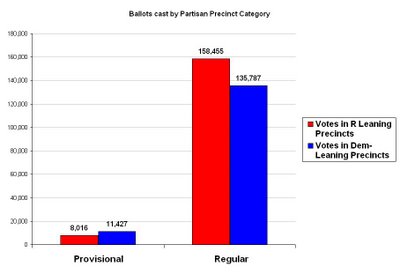In Extremis #1, because people like graphs
There is quite a bit of hope resting on the outstanding provisional ballots here in Franklin County. Bev Campbell is still hoping for enough votes to defeat Jim McGregor in the 20th State House District, and Mary Jo Kilroy is still hoping to take the OH-15 Race away from Deb Pryce.
Democrats tend to hold out this hope because there is a belief that Provisional Votes break for the Democrats. This is due, once again, to the increased housing instability which leads to greater rates of provisional voting, among low income urban voters, who tend to vote for Democrats. But does it really happen?
First, let me tell you why you shouldn't believe it. Each graph you see here (and most every one elsewhere) is based on Provisional Ballots cast. There is every reason to believe that Republicans will hold the same advantages in having Provisional Ballots accepted as they did in avoiding having to cast such ballots in the first place.
Now, however, I'll show you some actual data supporting that belief. Using the proportion of the vote that went to Sykes as a proxy for Dem Partisanship (see earlier post-mortems), it's obvious that as Dem partisanship increases, the proportion of ballots that are cast provisionally also increases:
What is also obvious, is that this line isn't nearly as clean as some of the others I've plotted. The relationship holds fairly well for Republican and Swing Districts, and goes totally non-linear for Dem Precincts. This brings up two points: A) It seems that Dem Leaning districts are categorically different in terms of provisional ballot usage, and B) Yes, these high-Dem precincts are the same ones that I said tended to be lower in turnout.
To look at this, I divided the precincts into D-Leaning (Sykes Vote > 50%, n=323) and R-Leaning (Sykes vote <= 50%, n=410). By percentage, 5.1% of R-leaning precinct votes were cast provisionally, as opposed to 8.4% in D-leaning precincts (more than 1.5 times the rate). By gross votes, more than 20,000 more regular votes were cast in R-precincts than in D-precincts, but 3000+ more provisional votes were cast in D-leaning precincts. 
Finally, it is not unreasonable to assume that within each individual precinct, that Dem voters were more likely than R voters to vote provisionally, which would intensify the effects displayed at the precinct level. I'll do my final post-mortem after the votes are counted this weekend.
No comments:
Post a Comment